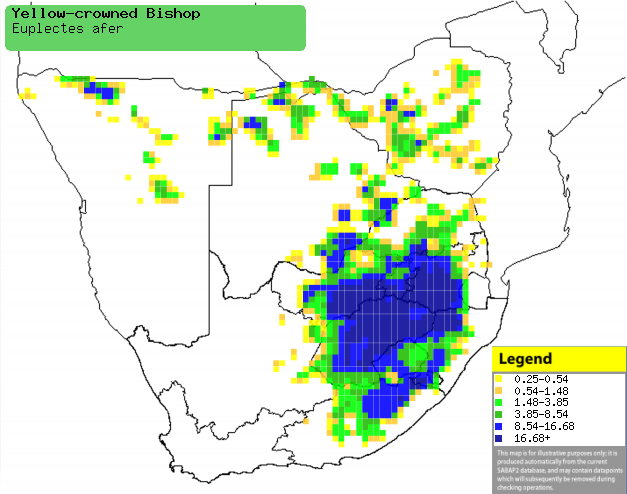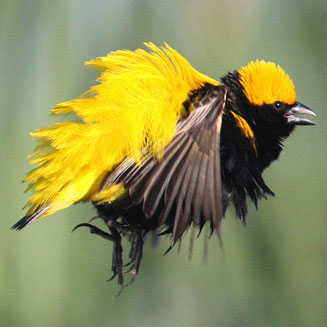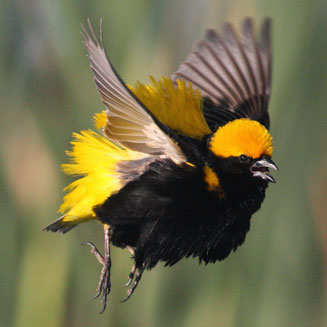|
Euplectes afer
(Yellow-crowned bishop, Golden bishop)
Goudgeelvink [Afrikaans]; Kambara
(generic term for weaver and also applied to Yellow-crowned bishop)
[Kwangali]; Thaha-pinyane, Thaha-tsehle, Tsehle [South Sotho]; Mantunje,
Xikhungumala [Tsonga]; Napoleonwever [Dutch]; Euplecte vorabé [French];
Tahaweber, Napoleonweber [German]; Cardeal-tecelão-amarelo [Portuguese]
Life
> Eukaryotes >
Opisthokonta
> Metazoa (animals) >
Bilateria >
Deuterostomia > Chordata >
Craniata > Vertebrata (vertebrates) > Gnathostomata (jawed
vertebrates) > Teleostomi (teleost fish) > Osteichthyes (bony fish) > Class:
Sarcopterygii (lobe-finned
fish) > Stegocephalia (terrestrial
vertebrates) > Tetrapoda
(four-legged vertebrates) > Reptiliomorpha > Amniota >
Reptilia (reptiles) >
Romeriida > Diapsida > Archosauromorpha > Archosauria >
Dinosauria
(dinosaurs) > Saurischia > Theropoda (bipedal predatory dinosaurs) >
Coelurosauria > Maniraptora > Aves
(birds) >
Order: Passeriformes > Family: Ploceidae
> Genus: Euplectes
Distribution and habitat
Occurs in isolated patches across sub-Saharan Africa, from
Senegal to southern Sudan yet absent from the DRC, south to southern Africa.
Here it is locally common in the eastern half of South Africa, with more
localised populations in northern Namibia, northern and south-eastern Botswana
and Zimbabwe. In the breeding season it mainly occupies marshes or seasonally
flooded areas, but when isn't breeding it can move into dry habitats such as
cultivated areas.
|
 |
|
Distribution of Yellow-crowned bishop in southern Africa,
based on statistical smoothing of the records from first SA Bird Atlas
Project (©
Animal Demography unit, University of
Cape Town; smoothing by Birgit Erni and Francesca Little). Colours range
from dark blue (most common) through to yellow (least common).
See here for the latest distribution
from the SABAP2. |
Predators and parasites
It has been recorded as prey of Barn owl (Tyto alba),
while its chicks are eaten by Yellow-billed egrets
(Egretta intermedia)
Food
It mainly eats seeds taken from the ground or directly from
plants, often joining mixed species foraging flocks along with other widowbirds,
bishops and queleas. The following food items have been recorded
in its diet:
- Plants
- seeds
- Setaria flabellate (Creeping setaria)
- Panicum maximum (Guinea grass)
- maize
- flowers of Melinis repens (Natal redtop)
- Insects (recorded in captivity only)
Breeding
- Polygynous, colonial breeder, living in small colonies, each with one male
who controls about 2-3 nests and multiple females. Males defend their
territory and attract females by fluffing out their yellow back feathers and
calling, sometimes performing display flights while doing so (see images
below).
 |
 |
|
Yellow-crowned bishop males displaying, Mpumalanga,
South Africa. [photo
Johan van
Rensburg ©] |
- The male builds a ball-shaped nest with a side-top entrance, made of
woven grass-strips and, if accepted by the female, she lines the interior
with grass seedheads. It is typically suspended between grass stems over
water, incorporating the tips of the grass stems into the roof, concealing
the entrance.
- Egg-laying season is from November-May, peaking from December-March.
- It lays 2-4 eggs, which are incubated solely by the female for about
12-14 days (recorded in captivity)
- The chicks are fed by the female only, leaving the nest after
approximately 11-13 days and becoming independent roughly 5 weeks later.
Threats
Not threatened.
References
-
Hockey PAR, Dean WRJ and Ryan PG 2005. Roberts
- Birds of southern Africa, VIIth ed. The Trustees of the John Voelcker
Bird Book Fund, Cape Town.
|
